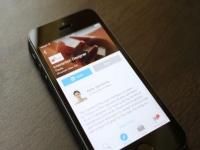LinkedIn says that today 40% of its 300 million users access the site on mobile devices, so its bid to tap into the wave of users accessing the site via smartphones and tablets continues apace: today the company is launching LinkedIn Job Search, a free iOS app that will let people search and apply for jobs on the social network.
And, interestingly for a company that has built out some interesting (if slightly unnerving) features tracking how people view each other’s profiles on the site, LinkedIn here has taken a different approach: everything you do on the job search app remains private.
“It can be hard to search for a job while you’re at your desk, not to mention the potentially awkward conversation with your current boss,” product manager Daniel Ayele notes in a blog post. “Our goal is to help make this process easier for you and to help you be discreet. Everything you do within the app will be completely private and not shared with your network.” (bolding mine)
This is LinkedIn’s first standalone app dedicated to these features.
The app is now live in the U.S. iOS App Store, with further versions in more markets coming soon, a spokesperson says.
This new job search app is the next step forward in LinkedIn’s attempts to make looking and applying for jobs more accessible on mobile devices; it follows an update made to LinkedIn’s main app in August 2013, when it added the ability to search and apply for jobs directly within the app.
LinkedIn says the new app has more features than what it had previously rolled into its main app:
– A more detailed way to search for, research, and apply for jobs, including customizations based on job title, location, company, industry, and seniority level.
– Tapping into LinkedIn’s ongoing search algorithm development, it will also offer tailored job recommendations based on saved searches as well as jobs a person has viewed and that person’s own LinkedIn profile.
– More detail on how your own network extends to the prospective company in question, as well as more facts about the company.
– And tapping into both the finite and fleeting nature of job availability, a notifications service so that you can keep up with when new jobs are coming up, or those you’ve flagged are closing their application window in case you’ve forgotten.
Apart from this, LinkedIn Job Search is significant for a couple of reasons.
The first is that it is about LinkedIn trying to play more to its strengths.
The company has been very ambitious about ramping up the kind of content it offers on LinkedIn.com, with a wave of moves like adding Pulse for news reading, opening the platform to members to publish their own content, and generally trying to look and act more like a social network and meeting ground for people to keep returning to the site regularly and think of it as their go-to place for professional information and networking.
But at the end of the day the company’s biggest business, right now, is in the area of recruitment.
Specifically, in the last quarter, “Talent Solutions”, which includes recruitment ads, accounted for 58% of LinkedIn’s revenue, $275.9 million. If you look at the company’s wider range of apps on iOS, half of them (three out of six) are related to LinkedIn’s job search and talent solution efforts. The others are aimed at the recruiters, rather than the job seekers. This is about filling that out with more traffic and tapping into where LinkedIn is already doing well.
The second is a bigger trend around how social networks are building out their app portfolios.
Facebook has made a big push into making strategic moves with standalone apps for specific features, be they established services like Messenger or new efforts like Slingshot. The reason: it drives way more traffic which is an important metric for ad-based businesses.
Last quarter, LinkedIn says that Marketing Solutions, its division that includes advertising, accounted for 22% of revenues, or $101.8 million, and grew by 36% over the year before.
By comparison, Talent Solutions grew by 50%, meaning that ads are an area that still has a lot of growth left in it.
So, with LinkedIn also looking to make revenue in ads, it looks like it too is going for a similar strategy to Facebook’s, increasing the ways that an already-healthy audience in mobile might become even more robust. It’s telling that the job search app is free, to encourage more use of it.
A LinkedIn spokesperson says that “for now” the job-seeking features will remain in the main app, with the dedicated app giving people a more detailed experience.
But it won’t come without competition. As I noted when LinkedIn first added job application features to its main app in August 2013, there are already a number of apps in the market that let people look for and apply for jobs on their mobile devices, as well as do extensive research on companies.
They include mobile efforts from large online players like CareerBuilder and Monster.com; standalone mobile-first efforts from the likes of JIBE and Proven; and Glassdoor, which puts a strong emphasis specifically on user feedback about a particular place to work. For those who are in high-demand roles, having that kind of extra information can sometimes be the key differentiator.

